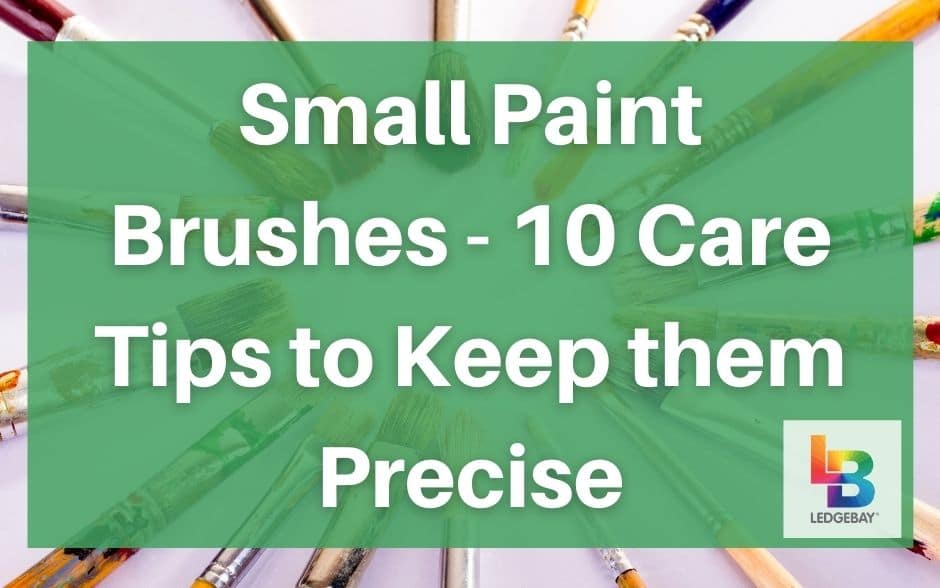When it comes to detail work, small paint brushes can help you get the job done like no other can. As useful as they are, fine and delicate brushes demand equally delicate treatment. Here's how to take care of your small brushes to keep them precise. Getting to know yourpaint brushes is the first step to taking good care of them. Your brushes can differ in materials and sizes, but their anatomy is always the same.
Getting to know yourpaint brushes is the first step to taking good care of them. Your brushes can differ in materials and sizes, but their anatomy is always the same.
The very end of the bristles on apaint brush is called the tip. The tip may be flattened on some brushes, but it’s pointed on fine or small brushes.
After the tip, you’ll see the belly, which is the middle section of the bristles. It’s called “belly” because the bristles swell at that part. Typically, smallpaint brushes have a little belly, so they don’t absorb a lot of paint.
Next up is the metal part of the brush, referred to as the ferrule. It supports the bristles and attaches them to the handle. If you examine the edge of the ferrule closest to the handle, you’ll see a pinch-point called the crimp.
Lastly, we have the longest part of apaint brush that’s often made of wood; the handle . The bestpaint brushes offer a thick grip between the crimp and the middle of the handle because this is where you’ll most probably hold the brush.
This isnot true and here’s why:
The ferrule is what gives the tip of the bristles its shape — a sharp point. If you letpaint build up inside the ferrule and it dries , the bristles will get “glued” together.
As a result, you’ll end uppainting with a hardened stick instead of a fluffed brush . You’ll lose thetip’s shape and the bristles will split and bend at weird angles when you try to paint , giving you uneven strokes.
When this happens, restoring your brush can be very difficult. This is why is it’s best to protect your ferrule beforehand and avoid drenching it in paint.
You can do this by not going past the belly of the bristles when you’repicking up paint . If you do get paint in your ferrule, try to follow the steps below as quickly as possible:
Instead of using one of your smallpaint brushes for dry brushing, find an old splitting brush to take the fall. You’ll end up saving money by not preserving your nice brushes.
Luckily, this scenario is easily avoidable by simply keeping your brushes wet while in use and cleaning them once you’re done.
The thing is, keeping a paint brush wet can be tricky if you’re working with acrylic paint since it uses aplastic polymer as a binder. Such material is easily altered by water, so even if you don’t notice any negative effects right away, watered-downacrylic paint will flake off of thecanvas over time.
In this case, you should wash each brush before setting it down if you’re not going to use it for over 10 minutes at a time.
If you have trouble maintaining this, you can just keep a cup of clean water and a few paper towels at your painting station. Use these to swish your brushes in the water and then squeeze out the excess paint and water before putting them down for a while. A lot of people park their paint brushes, big and small, inwater cups while painting . Unfortunately, they’re unaware that water candamage the bristles over time as well as mess up the shape of the tip due to the exerted pressure on it.
A lot of people park their paint brushes, big and small, inwater cups while painting . Unfortunately, they’re unaware that water candamage the bristles over time as well as mess up the shape of the tip due to the exerted pressure on it.
The right thing to do here is to store your small brushes flat on your painting station.
So instead of washing away excess paint from your small brushes, you’ll have to deal with thick pieces of dried paint stuck on their bristles.
To avoid this hassle, clean your brushes using warm water. It’ll help you get the paint off more easily. Using the same small brush to take paint out of the pot,mix paint , and apply paint is a wrong move. That’s because each time you do it, some paint may get in the ferrule, or at the very least, some paint will be stuck to the end of the bristles.
Using the same small brush to take paint out of the pot,mix paint , and apply paint is a wrong move. That’s because each time you do it, some paint may get in the ferrule, or at the very least, some paint will be stuck to the end of the bristles.
Instead, use any splitting or low-qualitybrush you have lying around to scoop out and mix paint . Your good small brushes should only serve to applypaint to the canvas .
A dime-sized pump of dish soap along with some warm water should do the trick
If you’re dealing with especially stubborn paint, try using oliveoil or vinegar to clean your small paint brushes.
There you have it, 10 caretips to help you keep your small paint brushes precise.
To shop our complete gallery ofpaint by numbers kits and paint brushes,CLICK HERE!
1. Get to Know Your Small Paint Brushes
 Getting to know yourpaint brushes is the first step to taking good care of them. Your brushes can differ in materials and sizes, but their anatomy is always the same.
Getting to know yourpaint brushes is the first step to taking good care of them. Your brushes can differ in materials and sizes, but their anatomy is always the same.The very end of the bristles on apaint brush is called the tip. The tip may be flattened on some brushes, but it’s pointed on fine or small brushes.
After the tip, you’ll see the belly, which is the middle section of the bristles. It’s called “belly” because the bristles swell at that part. Typically, smallpaint brushes have a little belly, so they don’t absorb a lot of paint.
Next up is the metal part of the brush, referred to as the ferrule. It supports the bristles and attaches them to the handle. If you examine the edge of the ferrule closest to the handle, you’ll see a pinch-point called the crimp.
Lastly, we have the longest part of apaint brush that’s often made of wood; the handle . The bestpaint brushes offer a thick grip between the crimp and the middle of the handle because this is where you’ll most probably hold the brush.
2. Don’t Get Paint in the Ferrule
When you’re loading yourbrush with paint , do your best to avoid getting paint near or in the ferrule. It can be pretty hard to reach paint stuck between the ferrule and the base of the bristles, so many artistschoose to ignore it because it seemingly doesn’t affect the tip of the brushThis isnot true and here’s why:
The ferrule is what gives the tip of the bristles its shape — a sharp point. If you letpaint build up inside the ferrule and it dries , the bristles will get “glued” together.
As a result, you’ll end uppainting with a hardened stick instead of a fluffed brush . You’ll lose thetip’s shape and the bristles will split and bend at weird angles when you try to paint , giving you uneven strokes.
When this happens, restoring your brush can be very difficult. This is why is it’s best to protect your ferrule beforehand and avoid drenching it in paint.
You can do this by not going past the belly of the bristles when you’repicking up paint . If you do get paint in your ferrule, try to follow the steps below as quickly as possible:
- Grab some rubbing alcohol, a sewing needle, and a couple of paper towels.
- Soak the bristles in rubbing alcohol.
- Use a paper towel to squeeze out as much of the excess paint as possible.
- Take the sewing needle and gently push it between the bristles close to the ferrule. Then, move it towards the tip of the brush, to guide any remaining paint away from the ferrule.
- Repeat these steps until the base looks cleaner and bristles feel more flexible.
3. Use a Suitable Brush for Dry brushing
Thedry brushing painting technique can save time yet still achieve great effects. But if you’re a fan of this method, then you know how quickly it can ruin a good brush.Instead of using one of your smallpaint brushes for dry brushing, find an old splitting brush to take the fall. You’ll end up saving money by not preserving your nice brushes.
4. Never Let Paint Dry on Your Paint Brushes
One of the worstthings you can do to your small brushes is let paint dries on their bristles. Not only will this make them a nightmare to clean, but it’ll also cause the bristles to become stiff and spread, resulting in uneven brush strokes.Luckily, this scenario is easily avoidable by simply keeping your brushes wet while in use and cleaning them once you’re done.
The thing is, keeping a paint brush wet can be tricky if you’re working with acrylic paint since it uses aplastic polymer as a binder. Such material is easily altered by water, so even if you don’t notice any negative effects right away, watered-downacrylic paint will flake off of thecanvas over time.
In this case, you should wash each brush before setting it down if you’re not going to use it for over 10 minutes at a time.
If you have trouble maintaining this, you can just keep a cup of clean water and a few paper towels at your painting station. Use these to swish your brushes in the water and then squeeze out the excess paint and water before putting them down for a while.
5. Don’t Store Your Brushes in Water Cups While Painting
 A lot of people park their paint brushes, big and small, inwater cups while painting . Unfortunately, they’re unaware that water candamage the bristles over time as well as mess up the shape of the tip due to the exerted pressure on it.
A lot of people park their paint brushes, big and small, inwater cups while painting . Unfortunately, they’re unaware that water candamage the bristles over time as well as mess up the shape of the tip due to the exerted pressure on it.The right thing to do here is to store your small brushes flat on your painting station.
6. Avoid Using Hot Water to Clean Your Paint Brushes
You may think it’s reasonable to use hot water for cleaning paint brushes, but it’s something you should never do. Why? Because hot water causesoil and acrylic paints to clot.So instead of washing away excess paint from your small brushes, you’ll have to deal with thick pieces of dried paint stuck on their bristles.
To avoid this hassle, clean your brushes using warm water. It’ll help you get the paint off more easily.
7. Don’t Use the Same Brush for Scooping Paint Out of the Pot, Mixing Paint, and Painting
 Using the same small brush to take paint out of the pot,mix paint , and apply paint is a wrong move. That’s because each time you do it, some paint may get in the ferrule, or at the very least, some paint will be stuck to the end of the bristles.
Using the same small brush to take paint out of the pot,mix paint , and apply paint is a wrong move. That’s because each time you do it, some paint may get in the ferrule, or at the very least, some paint will be stuck to the end of the bristles.Instead, use any splitting or low-qualitybrush you have lying around to scoop out and mix paint . Your good small brushes should only serve to applypaint to the canvas .
8. Change the Rinsing Water Regularly While Painting
Your smallpaint brushes may look clean when you rinse them in murky paint water , but in reality, they’re not. Such water contains a lot of paint particles, so there’s a chance you’ll damage the bristles and the ferrule if you store your brushes in it.9. Clean Your Brushes with Dish Soap
[amazon box="B01MG2BJF0"]A dime-sized pump of dish soap along with some warm water should do the trick
10. Use Olive Oil or Vinegar to Remove Hard-to-Wash Paints
[amazon box="B07BCX2YNG"]If you’re dealing with especially stubborn paint, try using oliveoil or vinegar to clean your small paint brushes.
- For oil paint, soak the bristles in olive oil for about 20 to 25 minutes.
- For acrylic paint, heat some white vinegar in a microwave until warm then soak the bristles in the vinegar for about 10 to 15 minutes.
Small Paint Brushes - Wrap Up
[amazon box="B07ZMJKMWQ"]There you have it, 10 caretips to help you keep your small paint brushes precise.
To shop our complete gallery ofpaint by numbers kits and paint brushes,CLICK HERE!











